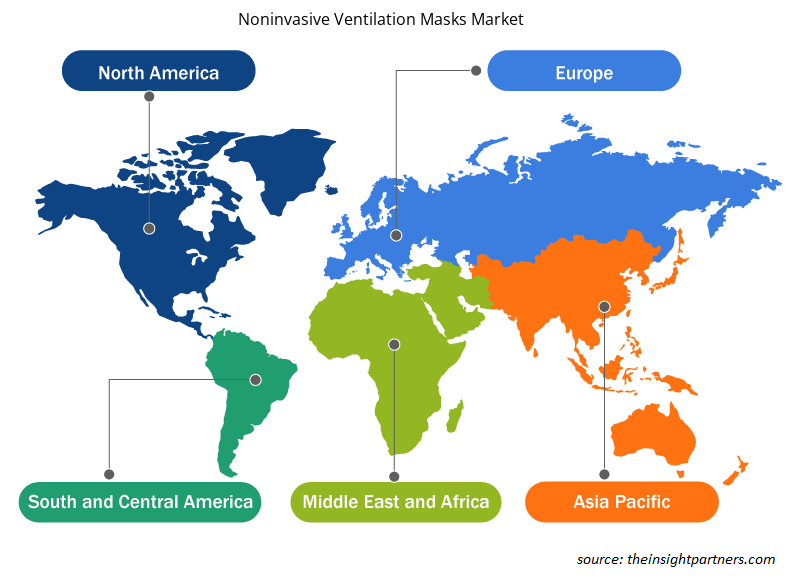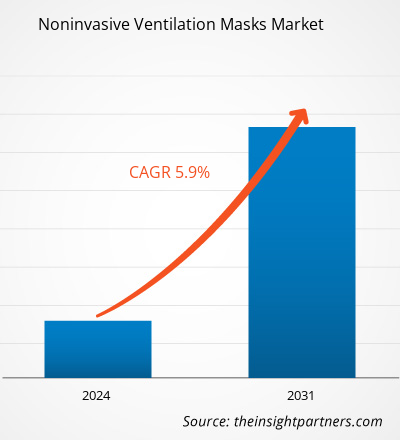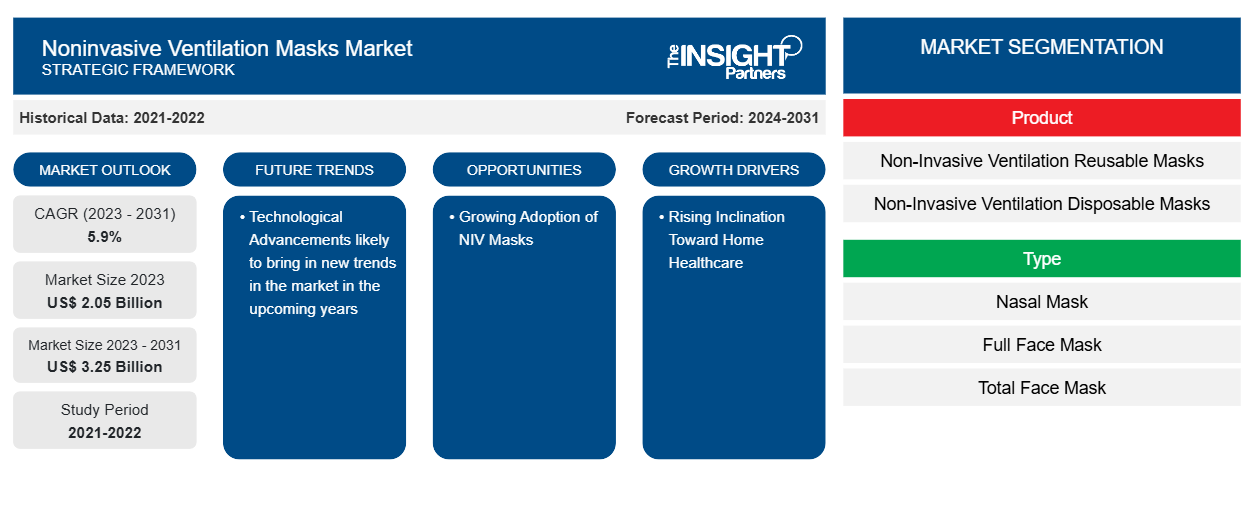Der Markt für nichtinvasive Beatmungsmasken soll von 2,05 Milliarden US-Dollar im Jahr 2023 auf 3,25 Milliarden US-Dollar im Jahr 2031 anwachsen. Der Markt soll zwischen 2023 und 2031 eine durchschnittliche jährliche Wachstumsrate (CAGR) von 5,9 % verzeichnen. Die zunehmenden technologischen Fortschritte bei nichtinvasiven Beatmungsmasken dürften in den kommenden Jahren ein zukünftiger Trend auf dem Markt sein.
Marktanalyse für nichtinvasive Beatmungsmasken
Bei COPD-Patienten werden invasive Beatmungsmethoden häufig vermieden, um das Risiko von Komplikationen wie Infektionen und mechanischen Lungenverletzungen zu verringern. Nichtinvasive Beatmungsmasken werden bevorzugt, da sie eine Atemunterstützung bieten, ohne dass eine Intubation erforderlich ist. Die chronische, langfristige Natur von COPD und Schlafapnoe führt daher zu Wiederholungskäufen und schafft eine Nachfrage nach NIV-Masken, wodurch ein stabiler, nachhaltiger Markt für Hersteller entsteht.
Marktübersicht für nichtinvasive Beatmungsmasken
Nach Schätzungen des National Council on Aging, Inc. litten im Jahr 2023 39 Millionen Erwachsene in den USA an OSA. Laut einem Artikel mit dem Titel „Was weiß eine gebrechliche Schweizer Bevölkerung über chronisch obstruktive Lungenerkrankung?“ litten im Jahr 2021 etwa 400.000 Menschen in der Schweiz an COPD. Bei der nichtinvasiven Beatmung (NIV) wird Sauerstoff über eine Gesichtsmaske verabreicht, wodurch die Notwendigkeit eines endotrachealen Atemwegs bei der Behandlung verschiedener Erkrankungen, darunter COPD, kardiogenes Lungenödem und andere Atemwegserkrankungen ohne Komplikationen wie Atemmuskelschwäche, Trauma der oberen Atemwege und beatmungsassoziierte Pneumonie, entfällt. Nichtinvasive Beatmungsmasken können wiederverwendbar oder Einwegmasken sein. Die Einweg-Beatmungsmasken sind für den einmaligen Gebrauch bestimmt und werden entsorgt, um das Risiko einer Kreuzkontamination zu verringern. Fortschritte bei Maskendesign, Komfort, Haltbarkeit und der Verwendung hautfreundlicher Materialien können die Einführung von NIV-Masken fördern, da Patienten nach effizienteren und bequemeren Produkten suchen. Daher wird erwartet, dass die Einführung von NIV-Masken als wirksame Behandlung dieser weit verbreiteten Atemwegserkrankungen das Wachstum des Marktes für nichtinvasive Beatmungsmasken in den Jahren 2023–2031 weiter ankurbeln wird.
Passen Sie diesen Bericht Ihren Anforderungen an
Sie erhalten kostenlos individuelle Anpassungen an jedem Bericht, einschließlich Teilen dieses Berichts oder einer Analyse auf Länderebene, eines Excel-Datenpakets sowie tolle Angebote und Rabatte für Start-ups und Universitäten.
-
Holen Sie sich die wichtigsten Markttrends aus diesem Bericht.Dieses KOSTENLOSE Beispiel umfasst eine Datenanalyse von Markttrends bis hin zu Schätzungen und Prognosen.
Markttreiber und Chancen für nichtinvasive Beatmungsmasken
Steigende Tendenz zum Markt für häusliche Gesundheitspflege
Eine Verlagerung von Langzeitpflegeeinrichtungen, stationärer Rehabilitation und Pflegeheimen hin zur häuslichen Pflege führt dank Cloud- und mobilitätsgesteuerten medizinischen Geräten zu einer besseren, konsistenteren und zeitnahen Interaktion zwischen Patient und Arzt . Der Ausbruch von COVID-19 hat die Bedeutung der häuslichen Gesundheitsfürsorge aufgrund der begrenzten Bettenkapazität in Krankenhäusern und eines Mangels an qualifiziertem Gesundheitspersonal deutlich gemacht. Mithilfe der häuslichen Gesundheitsfürsorge können medizinische Fachkräfte die Vitalfunktionen der Patienten aus der Ferne überwachen und Krankenhauseinweisungen vermeiden.healthcare's importance due to limited hospital bed capacity and a scarcity of skilled healthcare professionals. With the help of home healthcare, healthcare professionals can monitor patient's vitals remotely and avoid hospital admissions.
Darüber hinaus äußern Patienten mit Erkrankungen wie COPD, Schlafapnoe und anderen Atemwegserkrankungen immer häufiger den Wunsch, ihre Beschwerden zu Hause zu behandeln. Patienten können die NIV-Therapie bequem von zu Hause aus durchführen, ohne häufig ins Krankenhaus gehen zu müssen. Hausärzte verschreiben immer häufiger NIV-Masken als Bestandteil umfassender Beatmungspläne.COPD, sleep apnea, and other respiratory issues are increasingly expressing a preference for at-home management of their ailments. Patients can use NIV therapy in the comfort of their homes without having to make frequent visits to the hospital. Home healthcare providers are prescribing NIV masks more frequently as a component of all-encompassing respiratory care plans.
Aufgrund der wachsenden Beliebtheit der häuslichen Gesundheitspflege und der steigenden Nachfrage nach moderneren, kostengünstigeren und leicht zu bedienenden Geräten für den Heimgebrauch gewinnt der Markt für nichtinvasive Beatmungsmasken daher spürbar an Dynamik.
Zunehmende Nutzung von NIV-Masken bietet MarktchancenNIV Masks to Offer Opportunities for Market
Nichtinvasive Beatmungsmasken erfreuen sich zunehmender Beliebtheit und erweitern die Marktchancen, indem sie Innovationen vorantreiben. Wachsende Aufklärungskampagnen zu Atemwegserkrankungen wie COPD, Schlafapnoe und anderen ermöglichen eine frühere Diagnose und Behandlung. Die zunehmende Verschreibung und Verwendung von NIV-Masken zur Krankheitsbehandlung ist auf ein größeres Bewusstsein unter Patienten und medizinischem Fachpersonal zurückzuführen. Das steigende Bewusstsein für eine frühzeitige Diagnose wird daher voraussichtlich die Einführung von NIV-Masken vorantreiben und erhebliche Chancen auf dem Markt schaffen. Darüber hinaus treten Atemwegserkrankungen in Schwellenländern, insbesondere im asiatisch-pazifischen Raum, in Lateinamerika und im Nahen Osten, aufgrund von Umweltverschmutzung, Urbanisierung und veränderten Lebensstilen immer häufiger auf. Die nichtinvasiven Therapien werden in diesen Regionen immer bekannter, weshalb die Verwendung von NIV-Masken im Prognosezeitraum voraussichtlich weiter zunehmen wird.COPD, apneaNIV masks for disease management results from greater awareness among patients and healthcare professionals. Thus, emerging awareness of early diagnosis is likely to drive the adoption of NIV masks and create significant opportunities in the market. Moreover, respiratory illnesses are becoming more common in emerging economies, particularly in Asia Pacific, Latin America, and the Middle East, due to pollution, urbanization, and lifestyle changes. The noninvasive therapies are becoming widely known in these areas, owing to which the use of NIV masks is likely to continue to propel during the forecast period.
Segmentierungsanalyse des Marktberichts für nichtinvasive Beatmungsmasken
Wichtige Segmente, die zur Ableitung der Marktanalyse für nichtinvasive Beatmungsmasken beigetragen haben, sind Produkt, Anwendung und Endbenutzer.
- Basierend auf dem Produkt ist der Markt für nichtinvasive Beatmungsmasken in nichtinvasive Einwegmasken und nichtinvasive wiederverwendbare Beatmungsmasken unterteilt. Das Segment der nichtinvasiven Einwegmasken für die Beatmung hielt im Jahr 2023 einen größeren Anteil am Markt für nichtinvasive Beatmungsmasken.
- Basierend auf der Anwendung ist der Markt in obstruktive Schlafapnoe, chronisch obstruktive Lungenerkrankung, Lungenentzündung und andere unterteilt. Das Segment Schlafapnoe hielt im Jahr 2023 den größten Anteil am Markt für nichtinvasive Beatmungsmasken.
- Basierend auf dem Endverbraucher ist der Markt in Krankenhäuser und Kliniken, häusliche Pflege und andere segmentiert. Das Segment Krankenhäuser und Kliniken hielt im Jahr 2023 den größten Anteil am Markt für nichtinvasive Beatmungsmasken.
Marktanteilsanalyse für nichtinvasive Beatmungsmasken nach Geografie
Der geografische Umfang des Marktberichts für nichtinvasive Beatmungsmasken ist hauptsächlich in fünf Regionen unterteilt: Nordamerika, Asien-Pazifik, Europa, Süd- und Mittelamerika sowie Naher Osten und Afrika. Nordamerika dominierte den Markt im Jahr 2023. Die USA sind der größte und am schnellsten wachsende Markt für nichtinvasive Beatmungsmasken. Laut der American Medical Association litten im Jahr 2022 etwa 30 Millionen Menschen in den USA an Schlafapnoe; jedoch wurden nur 6 Millionen auf diese Erkrankung untersucht. Darüber hinaus wurden im selben Jahr bei etwa 14,8 Millionen Erwachsenen COPD diagnostiziert, die vierthäufigste Todesursache in den USA. Die zunehmende Verbreitung dieser chronischen Lungenerkrankungen dürfte die Nachfrage nach NIV-Behandlungsoptionen erhöhen und das Wachstum des Marktes für nichtinvasive Beatmungsmasken in den USA ankurbeln.
Darüber hinaus wird erwartet, dass die Präsenz führender Marktteilnehmer wie Sleepnet Corporation, Philips und Hamilton Medical, die NIV-Masken anbieten, und die strategischen Entwicklungen dieser Marktteilnehmer in den USA den Marktanteil nichtinvasiver Beatmungsmasken im Land im Prognosezeitraum erhöhen werden. So ging Sleepnet Corporation im August 2024 eine Partnerschaft mit einem renommierten US-Kinderkrankenhaus ein, um die Mini Me 2 NIV-Maske einzuführen, um die Auswirkungen innovativer medizinischer Geräte auf die Patientenversorgung zu untersuchen.
Regionale Einblicke in den Markt für nichtinvasive Beatmungsmasken
Die regionalen Trends und Faktoren, die den Markt für nichtinvasive Beatmungsmasken während des gesamten Prognosezeitraums beeinflussen, wurden von den Analysten von Insight Partners ausführlich erläutert. In diesem Abschnitt werden auch die Marktsegmente und die Geografie für nichtinvasive Beatmungsmasken in Nordamerika, Europa, im asiatisch-pazifischen Raum, im Nahen Osten und Afrika sowie in Süd- und Mittelamerika erörtert.

- Erhalten Sie regionale Daten zum Markt für nichtinvasive Beatmungsmasken
Umfang des Marktberichts zu nichtinvasiven Beatmungsmasken
| Berichtsattribut | Details |
|---|---|
| Marktgröße im Jahr 2023 | 2,05 Milliarden US-Dollar |
| Marktgröße bis 2031 | 3,25 Milliarden US-Dollar |
| Globale CAGR (2023 - 2031) | 5,9 % |
| Historische Daten | 2021-2022 |
| Prognosezeitraum | 2024–2031 |
| Abgedeckte Segmente |
Nach Produkt
|
| Abgedeckte Regionen und Länder |
Nordamerika
|
| Marktführer und wichtige Unternehmensprofile |
|
Marktteilnehmerdichte für nichtinvasive Beatmungsmasken: Auswirkungen auf die Geschäftsdynamik verstehen
Der Markt für nichtinvasive Beatmungsmasken wächst rasant, angetrieben durch die steigende Nachfrage der Endnutzer aufgrund von Faktoren wie sich entwickelnden Verbraucherpräferenzen, technologischen Fortschritten und einem größeren Bewusstsein für die Vorteile des Produkts. Mit steigender Nachfrage erweitern Unternehmen ihr Angebot, entwickeln Innovationen, um die Bedürfnisse der Verbraucher zu erfüllen, und nutzen neue Trends, was das Marktwachstum weiter ankurbelt.
Die Marktteilnehmerdichte bezieht sich auf die Verteilung der Firmen oder Unternehmen, die in einem bestimmten Markt oder einer bestimmten Branche tätig sind. Sie gibt an, wie viele Wettbewerber (Marktteilnehmer) in einem bestimmten Marktraum im Verhältnis zu seiner Größe oder seinem gesamten Marktwert präsent sind.
Die wichtigsten auf dem Markt für nichtinvasive Beatmungsmasken tätigen Unternehmen sind:
- Hamilton Medical AG,
- ResMed Inc,
- Fisher & Paykel Healthcare Corp Ltd,
- Air Liquide Medical Systems,
- Drägerwerk AG & Co KGaA,
Haftungsausschluss : Die oben aufgeführten Unternehmen sind nicht in einer bestimmten Reihenfolge aufgeführt.

- Erhalten Sie einen Überblick über die wichtigsten Akteure auf dem Markt für nichtinvasive Beatmungsmasken
Marktnachrichten und aktuelle Entwicklungen zu nichtinvasiven Beatmungsmasken
Der Markt für nichtinvasive Beatmungsmasken wird durch die Erhebung qualitativer und quantitativer Daten nach Primär- und Sekundärforschung bewertet, die wichtige Unternehmensveröffentlichungen, Verbandsdaten und Datenbanken umfasst. Nachfolgend sind einige der Entwicklungen auf dem Markt aufgeführt:
- SunMed übernahm das Geschäft mit Atemwegs- und Anästhesieverbrauchsmaterialien von Vyaire Medical. Diese Übernahme bündelte die Stärken beider Unternehmen, um Innovationen voranzutreiben, eine zuverlässige Produktversorgung sicherzustellen und hochwertige medizinische Produkte für bessere Patientenergebnisse bereitzustellen. [Quelle: SunMed Group Holdings LLC (AirLife), Unternehmenswebsite, März 2023].
- Intersurgical hat Pulmodyne übernommen, einen in den USA und Malaysia ansässigen Hersteller, der auf Atemwegs- und Beatmungsprodukte spezialisiert ist. Die Übernahme wird Intersurgicals Produktpalette erweitern, seine Präsenz auf dem US-Markt stärken und den Absatz von Pulmodyne-Produkten weltweit steigern. (Quelle: ICU Medical, Unternehmenswebsite, Januar 2022)
Marktbericht zu nichtinvasiven Beatmungsmasken – Umfang und Ergebnisse
Der Bericht „Marktgröße und Prognose für nichtinvasive Beatmungsmasken (2021–2031)“ bietet eine detaillierte Analyse des Marktes, die die folgenden Bereiche abdeckt:
- Marktgröße und Prognose für nichtinvasive Beatmungsmasken auf globaler, regionaler und Länderebene für alle wichtigen Marktsegmente, die im Rahmen des Berichts abgedeckt sind
- Markttrends für nichtinvasive Beatmungsmasken sowie Marktdynamiken wie Treiber, Einschränkungen und wichtige Chancen
- Detaillierte PEST- und SWOT-Analyse
- Marktanalyse für nichtinvasive Beatmungsmasken mit Abdeckung der wichtigsten Markttrends, des globalen und regionalen Rahmens, der wichtigsten Akteure, der Vorschriften und der jüngsten Marktentwicklungen
- Branchenlandschaft und Wettbewerbsanalyse mit Marktkonzentration, Heatmap-Analyse, prominenten Akteuren und jüngsten Entwicklungen auf dem Markt für nichtinvasive Beatmungsmasken
- Detaillierte Firmenprofile
- Historische Analyse (2 Jahre), Basisjahr, Prognose (7 Jahre) mit CAGR
- PEST- und SWOT-Analyse
- Marktgröße Wert/Volumen – Global, Regional, Land
- Branchen- und Wettbewerbslandschaft
- Excel-Datensatz
Aktuelle Berichte
Erfahrungsberichte
Grund zum Kauf
- Fundierte Entscheidungsfindung
- Marktdynamik verstehen
- Wettbewerbsanalyse
- Kundeneinblicke
- Marktprognosen
- Risikominimierung
- Strategische Planung
- Investitionsbegründung
- Identifizierung neuer Märkte
- Verbesserung von Marketingstrategien
- Steigerung der Betriebseffizienz
- Anpassung an regulatorische Trends























 Kostenlose Probe anfordern für - Markt für nichtinvasive Beatmungsmasken
Kostenlose Probe anfordern für - Markt für nichtinvasive Beatmungsmasken